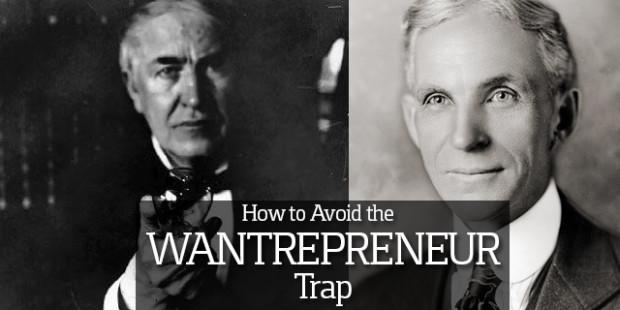Real Entrepreneurs Embrace Failure, Wantrepreneurs Are Defeated By It

It was Thomas Edison who said, “Genius is one percent inspiration and ninety-nine percent perspiration.” I believe that. Have you ever had an amazing idea only to see it come to fruition and then think…hey, but that was my idea! Contrary to what you may have been told as a kid, it’s not a great idea or a vivid imagination which leads to success – it’s the energy to roll up ones sleeves and make that intangible idea tangible. Ideas are plentiful. Success is all about execution and nothing great ever comes from a comfort zone! Your struggles are really your best growth opportunities but be careful not to fall into the wantrepreneur trap.
I thought about this for a while because I know wantrepreneurs. In fact, I grew up with a few. Great ideas are a dime a dozen, right? What makes those wantrepreneurs take action? Is it encouragement to look deep within oneself and find that elusive recipe for success? Is it reflecting on the qualities which all successful people share?
Visionaries like Henry Ford, Thomas Edison and even Mary Kay all shared similar qualities. In fact, the list would be a long one. These people embodied the concept that failure is part of the routine of success. Missteps, nay-sayers, defeat? Bring it on. That all sounds great, right? Understanding the similarities shared by successful people is inspirational to so many.
But it’s rubbish.
What makes a successful entrepreneur? A successful venture? I’m certainly not attempting to elevate my career successes to the level of Thomas Edison, but I do think it’s necessary to turn the mirror on myself. What’s made my business successful? It’s not always about great ideas. Sometimes it’s about getting up and actually making those ideas real. The first step isn’t the idea – the first step is taking the first step.
Thomas Edison was neither the first nor the only person trying to invent an electric lamp. By the time Edison invented the lightbulb, gas lighting was already a mature, well established industry. In fact, people had grown accustomed to the idea of gas lighting. First, Edison devoted his involvement to understanding why so many inventors before him had failed. Then he started experimenting. He needed to try, fail, try, fail, and keep trying until he got it right.
Henry Ford didn’t invent the automobile but he did have an idea about how to get the automobile to the masses in record time. He introduced the concept of conveyor belt assembly lines. He didn’t just dream about how to speed up the process of mass production – he came up with a plan and put the idea into practice.
I saw room for improvement in the steel construction industry. I don’t think I’m the first person to have seen the possibilities, the potential, the significant room for improving the customer experience. The business goal of a wantrepreneur is the money, while an entrepreneur’s goal is to be the best. I remember a colleague saying it would be impossible to go up against the established organizations even if the idea was to offer customers a fresh, streamlined approach to project management.
I took action, fear of failure be damned. I set up shop in my garage. My desk was a door on top of two opposing filing cabinets. I had a phone, a parka for the Colorado winter weather (brr!), my extensive knowledge of pre-engineered steel building systems, and most importantly, I had drive.
Sounds easy, doesn’t it? It wasn’t. I struggled. I sacrificed. I learned a lot of hard lessons along the way but I thought it was a good idea. No – I KNEW it was a good idea – one which would go nowhere until I faced the risk of failure head on.
It took a while but ideas only become real when you’re ready and willing to face objections squarely in the face and say to yourself, “The objection isn’t the problem, the problem is that I haven’t found the solution yet!”
My passion quickly took over.
Today, Armstrong Steel is an industry leader. And I continue to build. I come to work every day just as I ask my employees to do. I sit among them, I’m in the trenches. When an employee comes to me with an idea, I ask them what they need in order to make it happen – and I try to give it to them. And then I hold them accountable for making the idea happen – I let them own the success when it happens and I share the disappointment when it doesn’t, because I believe that the only failure in the process is owning the idea and letting someone else do it first.
But how do you do that?
I decided to share the informal process with you because it’s not as hard as it seems, and I want you to be successful, too, in whatever you endeavor. It’s a feeling like no other.
1. Come up with a plan
2. Decide where to start
3. START
4. Refine the process, find ways to improve systems, don’t give up
5. Ask people for help, people are always attracted to initiative
6. Learn what you don’t know
7. Money isn’t your most valuable resource, the minds and experiences of others is
8. Figure out whats standing in your way
9. Kick those things out of the way
10. Keep pushing
 I certainly don’t pretend to have all the answers. I’m not that arrogant. I learn every day. But things happen not because I want them to happen but because I make them happen, everyday. A real entrepreneur creates what a wantrepreneur says is impossible. When it comes down to it, taking action is what really counts no matter how many good ideas you might have! Real entrepreneurs do what it takes to get the ball rolling when they say they will.
I certainly don’t pretend to have all the answers. I’m not that arrogant. I learn every day. But things happen not because I want them to happen but because I make them happen, everyday. A real entrepreneur creates what a wantrepreneur says is impossible. When it comes down to it, taking action is what really counts no matter how many good ideas you might have! Real entrepreneurs do what it takes to get the ball rolling when they say they will.
Am I saying I know how to make a better mousetrap? Absolutely not. But if a better mousetrap can be invented and I have the idea – well, mice had better look out.
Photo courtesy: Kara Hansen, Applied Nomadology, WikiImages« The Guide To A Seamless Office Move From Armstrong Steel
6 Ways To Raise Money For Your Practice Field »
Popular Posts

Permits are usually vital for your steel building project. The permitting process is in place to ensure a steel building is designed according to your municipality’s standards with regards to safety and approved zoning plans. Most building projects in major cities including new construction, remodeling and repairs require general building permits. It’s your responsibility as a buyer and first… …

OK, I admit it, I’m pretty much a news junkie. Like most CEO’s, I read about market trends, technology advancements, and about the geo-political landscape and how it impacts industry. I scan the business sections, monitor stories on the economy, and skim through Washington news. But I really devour stories that impact my customers’ lives… …

